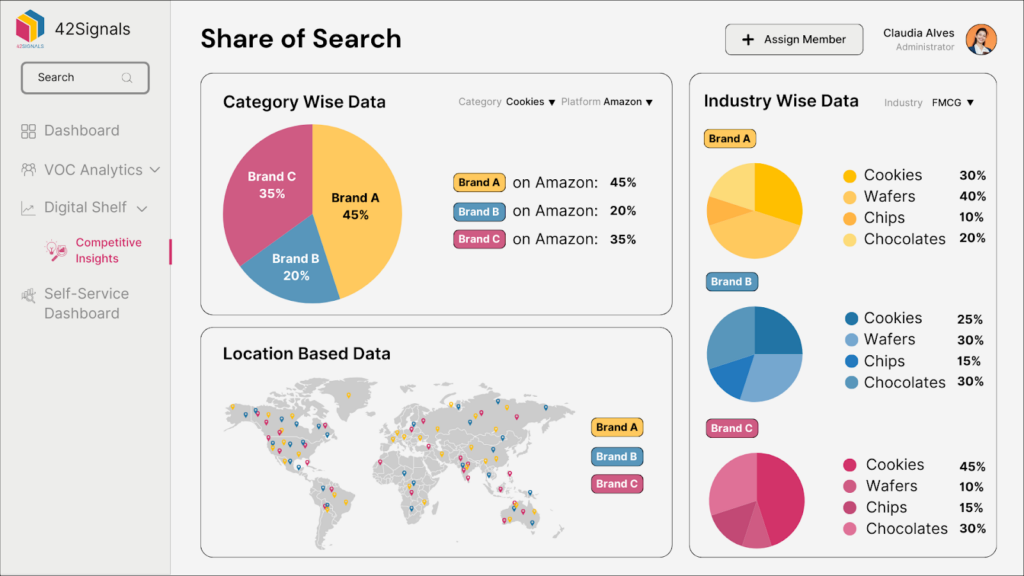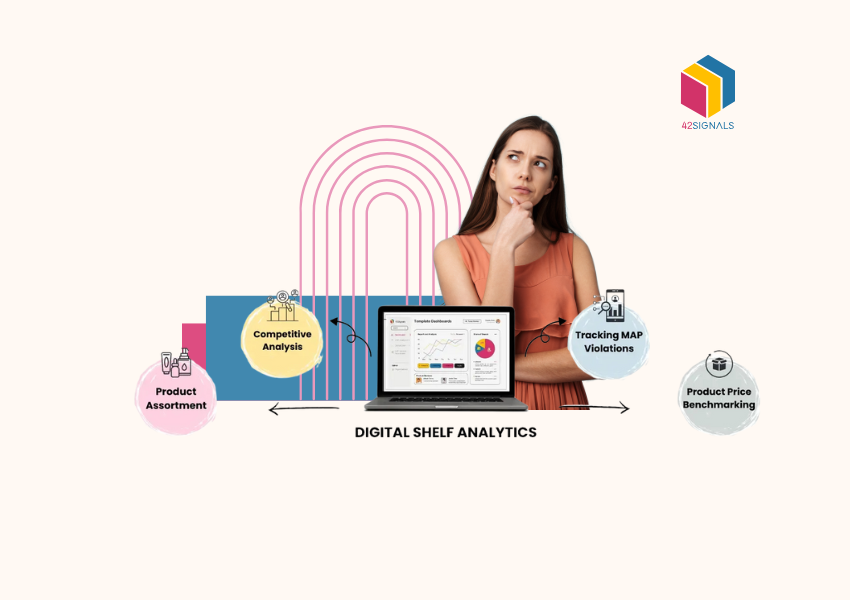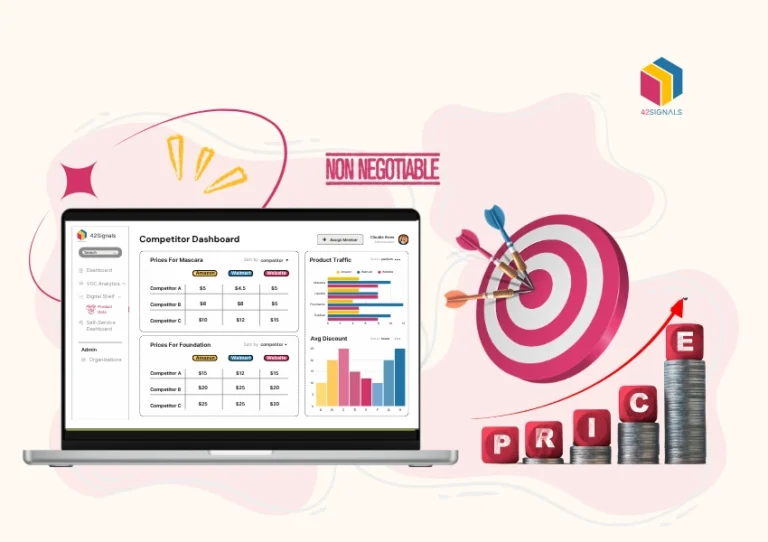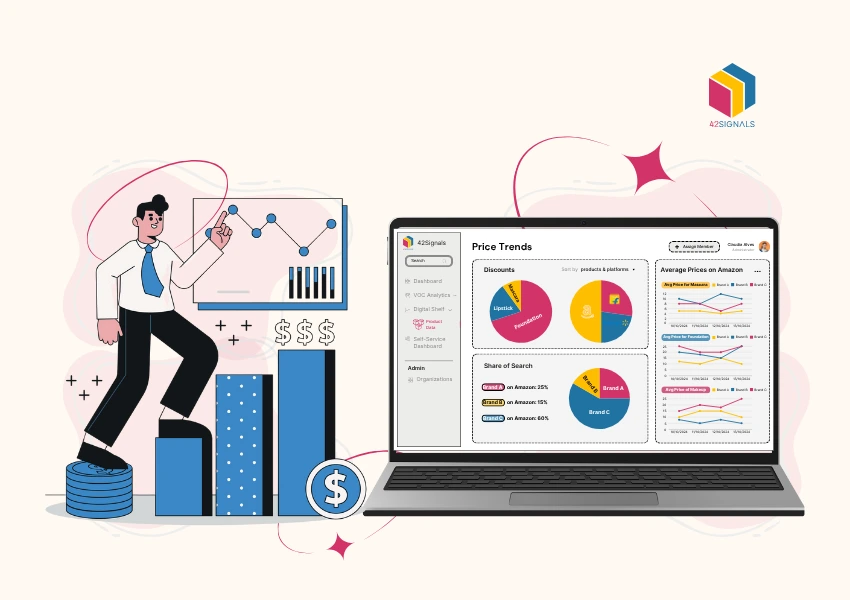Table of Contents
ToggleBrands operating today are battling it online and offline for visibility. Once this batter is won, they need to focus on winning customer loyalty. If a customer searches for, let’s say, Brand Unicart’s products online and finds outdated images or another seller/website selling the same item at a fraction of the cost, it can lead to damaging reputation and revenue. That’s why digital shelf monitoring is so important.
It helps brands serious about ecommerce success ensure accurate product data and prices on online marketplaces to catch any MAP violations.
What is Digital Shelf Monitoring?

The “digital shelf” refers to how your products appear across online channels—your website, Amazon, Walmart, social media, or any platform where customers discover and purchase your items. And, digital shelf monitoring involves tracking every element of your product’s online presence:
- Product data (descriptions, images, specs)
- Pricing (including MAP violations)
- Product Availability (stock levels, delivery times)
- Visibility (search rankings, share of search)
- Competitor activity (price changes, promotions)
It audits all platforms and data points to identify any anomalies. Without it, keeping tabs on your products and competitors would be next to impossible.
Why Digital Shelf Monitoring Can’t Be Ignored?
1. Product Data Accuracy Drives Conversions
In a physical store, a customer can pick up a product, feel its weight, and read the packaging. Online, the product data is the product. Inconsistent, incomplete, or inaccurate information is a direct conversion killer. If your title says “wireless headphones” on your website but “Bluetooth earphones” on Amazon, a shopper may not realize it’s the same item, leading to brand confusion. Worse, conflicting specifications, outdated imagery, or missing key features (like compatibility details or sizing charts) erode consumer trust instantly.
Digital shelf analytics tools scan every platform to ensure your product data is uniform and optimized. They automate the tedious process of manually checking hundreds of SKUs across dozens of retailers.

Consider this extended example: A premium skincare brand using these tools noticed a 30% sales drop for a best-selling moisturizer specifically at Walmart.com. The culprit wasn’t pricing or competition, but an old product image showing the previous, now-discontinued packaging.
New customers, unfamiliar with the old design, were likely skeptical of its authenticity, fearing it might be expired or counterfeit. The brand’s monitoring tool flagged this discrepancy immediately. They coordinated with Walmart’s catalog team to update the image, and sales returned to their previous levels within days. This single insight salvaged a critical revenue stream and protected brand integrity on a major marketplace.
2. Share of Search Determines Market Share
“Share of search” measures how often your products appear in search results compared to competitors. If your items aren’t ranking for key terms, you’re invisible to shoppers. Digital shelf monitoring tracks this metric in real time, revealing gaps in SEO, content, or pricing strategies.

A mid-sized kitchenware brand, for instance, was investing heavily in paid search ads for terms like “non-stick cookware.” However, their digital shelf reporting showed their organic listings were consistently buried on page 3 of results, making them entirely dependent on paid clicks.
By using their analytics platform to reverse-engineer the top-ranking competitors’ listings, they identified a pattern: the top performers all included high-volume keywords like “PFOA-Free,” “Dishwasher Safe,” and “Oven Safe To 500°F” directly in their product titles and bullet points. The brand revamped their content across all retailers to incorporate these terms, leading to a 65% boost in organic traffic and a significant reduction in their customer acquisition cost.
3. MAP Violations Erode Profit Margins
Minimum Advertised Price (MAP) policies are essential for maintaining brand prestige, protecting retailer relationships, and ensuring healthy profit margins for all channel partners. Unchecked MAP violations are corrosive. They devalue your brand, alienate loyal retailers who invest in your products, and, for newer brands, can make products appear cheap or even scammy to discerning consumers.
Manually hunting for these violations is like searching for a needle in a haystack. Digital shelf analytics tools provide automated, instantaneous alerts the moment a product is listed below your agreed-upon MAP.
One electronics manufacturer identified a third-party seller on eBay listing their flagship headphones at 40% below MAP. This not only undercut their authorized retailers but also raised red flags about the product’s source (was it refurbished, stolen, or counterfeit?). Armed with concrete evidence, the brand’s legal team swiftly enforced their policy, shutting down the unauthorized seller and reclaiming control over their pricing and brand narrative.
4. Pricing Analytics Keep You Competitive (and Profitable)
Pricing in ecommerce is a high-stakes, dynamic game. A competitor’s flash sale, a shift in a marketplace’s algorithm, or a sudden change in demand can render your pricing strategy obsolete overnight, tanking your sales and profitability. Digital shelf monitoring provides granular, real-time pricing intelligence that empowers you to move from a reactive to a proactive stance. These tools provide a clear view of:
- How do your prices compare to competitors in real time
- Demand fluctuations during holidays or sales events
- Regions where discounts could boost conversions without hurting margins
A toy company leveraged this data during the volatile Black Friday period. Instead of slashing prices across the board, they used their dashboard to monitor competitor moves hourly. They noticed a key rival deeply discounting a specific action figure, but not their core playset.
The company chose to hold firm on the playset’s price while offering a modest, targeted discount on complementary items. This strategy allowed them to avoid a profit-crushing price war on their high-margin products while still appearing competitive and driving valuable bundle sales.
5. Competitor Analysis Uncovers Hidden Opportunities
The digital shelf offers an unprecedented opportunity for competitive intelligence. You can see your competitors’ best-selling products, their pricing strategies, their promotional calendars, and the keywords they are winning.

- What’s your competitor’s best-selling product?
- How often do they discount?
- What keywords are they targeting?
Digital shelf monitoring turns this public data into a strategic playbook. When a rising fitness apparel brand noticed a rival’s sudden and sustained spike in sales for “high-waisted yoga leggings,” they didn’t just guess at the cause. They used their analytics platform to perform a deep dive into the competitor’s product pages.
The discovery was invaluable: the competitor had recently added a gallery of dozens of user-generated photos and videos showcasing real customers wearing the leggings. This social proof addressed key purchase hesitations around fit, fabric, and appearance, dramatically boosting trust and conversion rates.
Armed with this insight, the brand quickly launched a UGC campaign, incentivizing customers to share photos with a branded hashtag. Within weeks, they began integrating this powerful, authentic content into their own product listings. This move, inspired directly by competitor analysis, led to a 25% increase in conversion rates for that product category, allowing them to effectively close the gap with their rival.
How to Build a Digital Shelf Monitoring Strategy?

Image Source: Gepard
Step 1: Audit Your Current Digital Shelf Health
Use tools like 42Signals to scan all platforms for:
- Inaccurate or missing product data
- MAP violations and unauthorized sellers
- Poor search rankings or low share of search
- Competitor pricing and promotion trends
These information points can strengthen understanding of what’s working and what needs to be improved. It can also highlight what competitors are doing better than your brand.
Step 2: Standardize Product Data Across Channels
Create a unified product information template for all retailers, including:
- High-resolution images and videos
- Consistent titles, descriptions, and keywords
- Up-to-date specs and compliance badges
Having standardized descriptions and images across marketplaces projects a unified and strong brand. It means a consumer shopping on any part of the internet will have the same information and if they choose a different source, will not see different messaging/imagery.
Step 3: Automate Monitoring and Alerts
Set up real-time alerts for:
- Price changes (yours and competitors’)
- Stockouts or listing removals
- New unauthorized sellers or MAP violations
Another crucial step is understanding what’s changing and, more importantly, when. This data and timely alerts from a platform like 42Signals can nip issues in the bud.
Step 4: Act Fast on Insights
- Negotiate with retailers to fix pricing errors.
- Report and remove counterfeit listings.
- Adjust SEO or content based on share of search gaps.
When all the data is understood and properly categorized, take prompt action to rectify the issues before they fester.
The Cost of Ignoring Your Digital Shelf
Choosing to neglect digital shelf monitoring is not a simple oversight; it is a conscious decision to cede control of your brand’s online presence, profitability, and future growth. The risks extend far beyond mere missed opportunities, evolving into active threats that can cause significant and lasting damage. Brands that fail to prioritize this critical function risk three catastrophic outcomes:
- Lost Revenue: 89% of shoppers won’t buy from a site with inaccurate product info.
- Discovery: If your products aren’t optimized for the right keywords (e.g., “organic cotton baby clothes” vs. just “baby clothes”), they won’t appear in search results. You lose the customer before they even know you exist.
- Evaluation: Incomplete or conflicting specs (e.g., different dimensions on Amazon vs. your website), missing lifestyle imagery, or absent sizing charts create friction and doubt. Online shoppers cannot ask a sales associate for clarification; they can only click away to a competitor’s listing that provides the answers they need.
- Conversion: Out-of-stock displays on retailer sites, even when you have ample inventory, instantly vaporize sales. Without monitoring, you may not even know this is happening for days or weeks, resulting in a continuous revenue bleed.
- Damaged Reputation: MAP violations and counterfeit sellers erode consumer trust.
- MAP Violations: When retailers or unauthorized sellers consistently list your products below Minimum Advertised Price, it devalues your brand in the consumer’s eyes. A premium product constantly on discount becomes perceived as lower quality. This alienates your loyal brick-and-mortar retail partners who cannot compete with rogue online pricing, potentially leading them to drop your line altogether.
- The Counterfeit and Gray Market Crisis: Unmonitored marketplaces are breeding grounds for counterfeiters and unauthorized sellers. These sellers often use stolen images and descriptions to move fake, expired, or stolen goods. The customer who receives a subpar or dangerous counterfeit product blames your brand, not the anonymous marketplace seller. This leads to a torrent of negative reviews on your official product pages, damaging your reputation for quality and safety—a blow that can take years to recover from.
- Inconsistent Brand Experience: A customer who sees a professional, high-end product on your website but finds it listed with grainy images and poor copy on a major retailer’s site experiences cognitive dissonance. This inconsistency signals a lack of care and professionalism, making customers question the legitimacy of your entire operation.
- Missed Trends: Competitors capitalize on pricing or SEO opportunities you overlook.
- Pricing Blind Spots: A competitor might launch a targeted 20%-off promotion in a specific region, capturing the entire first page of search results and decimating your sales for a key product. Without real-time pricing alerts, you might not discover this until your monthly sales report shows a catastrophic drop—weeks after the problem began.
- SEO Opportunities Lost: Share of Search is a leading indicator of market share. If you’re not monitoring which competitor keywords are rising in volume or which new product features are resonating in reviews, you are forever playing catch-up. Your content remains static while agile competitors continuously optimize, capturing ever-larger slices of organic traffic.
- Innovation Lag: Digital shelf analysis isn’t just about defense; it’s your greatest tool for innovation. By monitoring competitor listings, you can see which new product variations are launched, which bundles are popular, and what kind of content (e.g., videos, UGC) drives engagement for them. Ignoring this rich competitive intelligence means your product development and marketing strategies are based on internal guesswork, not external market reality.
These problems tend to have a snowball effect, getting bigger and harder to deal with as time passes by. Prompt addressal and constant monitoring of issues are absolutely essential.
Conclusion
In ecommerce, your digital shelf isn’t just a sales channel—it’s the frontline of your brand’s survival. From safeguarding pricing integrity with MAP enforcement to optimizing product data for search, every detail matters.
Tools like 42Signals offer actionable insights to protect your revenue, outmaneuver competitors, and deliver seamless shopping experiences. The question isn’t whether you can afford to invest in digital shelf monitoring—it’s whether you can afford not to.
Ready to Take Control of Your Digital Shelf? Schedule a demo with 42Signals today to see how real-time analytics can transform your ecommerce strategy.
Frequently Asked Questions
What is digital shelf monitoring?
Digital shelf monitoring is the ongoing process of tracking how a brand’s products appear across online retailers, marketplaces, and e-commerce platforms. It involves observing key elements like product titles, images, descriptions, pricing, availability, ratings, and reviews to ensure consistency, visibility, and competitiveness. This practice helps brands identify gaps, enforce content standards, and stay ahead of competitors in crowded digital environments.
What is a digital shelf tool?
A digital shelf tool is a software platform designed to automate the collection and analysis of product-related data from online retail channels. These tools help brands monitor product performance across multiple e-commerce sites, alert them to issues like stockouts or content mismatches, and provide insights to optimize their listings. Common features include content compliance checks, price tracking, review analysis, and share of search measurement.
What is digital shelving?
Digital shelving refers to how products are displayed, ranked, and found in an online store or marketplace—much like physical placement on a store shelf. It encompasses everything from search result positioning and product detail pages to visual content, ratings, and category listings. Just like physical shelves influence shopper behavior, digital shelving directly impacts visibility, click-through rates, and conversion in the e-commerce space.
What is digital shelf optimisation?
Digital shelf optimization is the process of improving how products appear and perform across e-commerce platforms. This includes enhancing product content (titles, descriptions, images), ensuring keyword relevance, maintaining stock availability, managing pricing, and collecting reviews. The goal is to increase discoverability, drive conversions, and outperform competitors by fine-tuning the digital presentation of your products.







